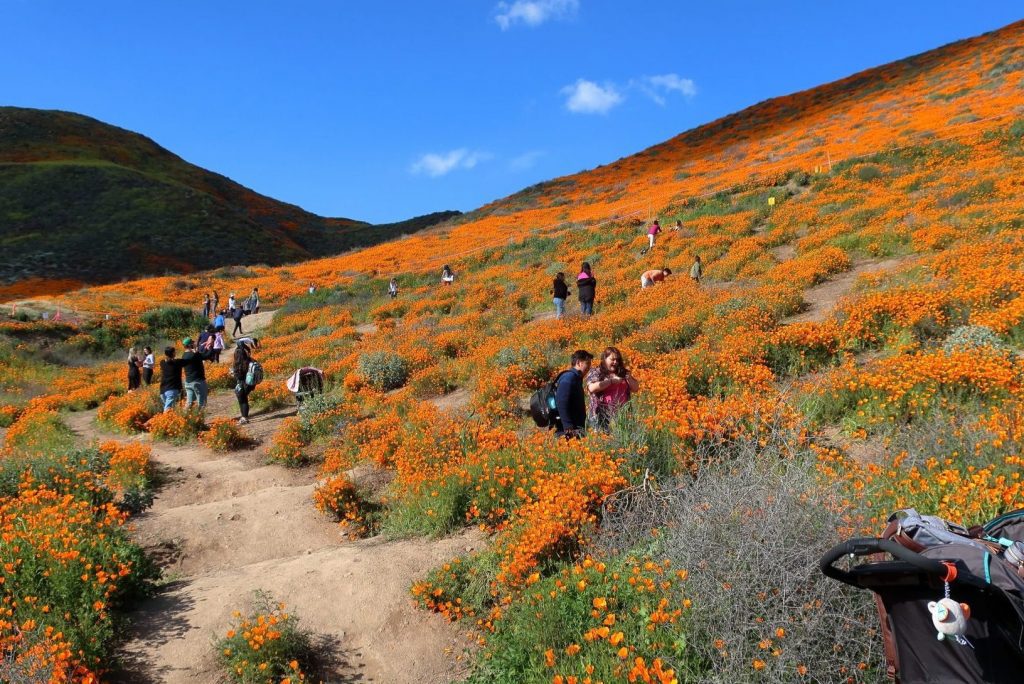Skift Take
Lake Elsinore, California wanted tourists — but not the kind that gridlocked its streets and trampled its mountainsides. The city is trying to learn from intense short-term overtourism to prepare for a more manageable future.
The attention started humbly enough: a trickle of stories about the poppy bloom in Lake Elsinore, a city in Southern California.
In mid-February, Forbes included the area in a list of the 16 most beautiful places to visit this spring, calling the upcoming bloom “one of the most spectacular wildflower experiences in the lower 48.”
Reuters followed a couple weeks later with a vibrant slideshow and video, and before long all the coverage — from local to global — and social media posts created a fervor.
“The next weekend, everybody was out,” said Lake Elsinore Mayor Steve Manos, who came up with the term “poppy apocalypse,” in an interview Wednesday night. “We ended up having absolute gridlock on both our freeway and then interior roads.”
Earlier this month, his city of roughly 63,000 people unexpectedly joined destinations all over the world that have struggled with overtourism, from Dubrovnik to Iceland to a sunflower patch in Ontario.
While tourism boards, tour operators, and travel agents have looked for ways to spread visitors out by promoting off-season visits or less-traveled corners of a city, Lake Elsinore is facing a different kind of problem: pop-up overtourism, the kind that lasts for a finite amount of time in one specific place.

An image from the Facebook page of the city of Lake Elsinore.
‘Walloped’
Lake Elsinore has seen blooms in recent years, though the last one in 2017 wasn’t as Instagram-worthy as this year’s. The California poppies — which are not to be confused with opium poppies — bloom under certain conditions: the right amount of water, the right soil temperature. As a result, it’s hard to predict when a tourist-generating “super bloom” might emerge.
“This year we had a really vibrant bloom, both in quality and quantity,” Manos said. “It really lit up the mountainside.”
Two weekends ago, law enforcement officials estimated that 20,000 people visited each day, Manos said. City officials realized that, unlike previous years when interest was relatively light, they needed to manage the crowds.
“This is a social media viral event that is attracting tens of thousands of visitors to our city,” Manos said during a press conference Thursday.
The city scrambled to designate parking areas, direct traffic, and offer shuttle service from remote lots. But the following weekend — March 16 and 17 — got even more overwhelming.

Lake Elsinore Mayor Steve Manos in a Facebook video.
“We just got walloped,” Manos said. “We planned for 20,000 and we thought we had the traffic plan to deal with that.”
But he said Saturday brought more like 50,000 people. And Sunday, “when everything broke down,” the number was as much as double that, the mayor said. Over the weekend, someone got bit by a snake, a worker was clipped by a car, some visitors passed out, and portable restrooms proved unable to handle the crowds. The shuttle system had to stop running.
“Everything that could go wrong went wrong,” Manos said. Through it all, he has provided updates on his Facebook page through posts and videos.
The city shut down the canyon — mostly conserved land — and parking sites and told everyone they could leave, but no one was allowed back in.
“It was a public safety issue on Sunday,” he said. “That said, there are limits to government authority, and you can’t simply close down a mountain; there’s many problems with that both with logistics and legality.”
“After news started spreading about how the super bloom had turned into a poppy armageddon,” the city got the attention of state, regional, and county authorities, Manos said. Officials held a press conference Thursday afternoon to address road closures, stepped-up enforcement against those who park on the highway, shuttle service details, and resident-only routes. There’s a super bloom hotline, and official city websites and social media channels include updated information.
The poppy apocalypse was just the latest headache for the city, which dealt with a large wildfire in nearby Cleveland National Forest as well as heavy rains and floods last year.
“We’ve had fires, floods, and now we’re dealing with flowers,” said Manos, who has a day job — that he hasn’t been able to do lately — working in real estate consulting.
Pivot Toward Tourism
Despite the frustration of residents, some of whom have floated the idea of weed killer as a solution, the news hasn’t all been bad.
Sales have been brisk at the city’s outlet mall, and restaurants in town have been so busy they’ve run out of menu items. Manos has discovered visitors from India, Canada, Wisconsin, and Idaho — and some have asked to take pictures with him.
The mayor sees an opportunity for the future: Lake Elsinore calls itself the “Action Sports Capital of the World,” with a recreation center, sports complex, skydiving, dirt bike track, and Minor League Baseball. Though there isn’t a destination marketing organization, Lake Elsinore — a onetime Hollywood getaway — is trying to organize its hotels into a tourism district.
“We are a city that’s pivoting toward tourism,” Manos said in Thursday’s press conference. “This is actually a great test for this city to see how it handles stresses caused by high numbers of visitors.”
While the immediate focus is on traffic and public safety, Manos said the bigger-picture tourism plan will follow.
“How do we go ahead and do this better next time and work this into other parts of our tourism plan?” Manos said. “It certainly is an opportunity.”
For better or worse, Lake Elsinore’s time in the spotlight isn’t likely to last much longer.
Dustin McLain, parks and resources chief for the Riverside County Regional Park and Open-Space District, said during Thursday’s press conference that the poppies are starting to wither. Biologists and botanists think the blooms have two to three weeks left.
“It’s on the downward trend,” he said, “It won’t be as magnificent as it is now.”
The Daily Newsletter
Our daily coverage of the global travel industry. Written by editors and analysts from across Skift’s brands.
Have a confidential tip for Skift? Get in touch
Tags: california, overtourism, tourism
Photo credit: Crowds are shown amid the blooming California poppies in Lake Elsinore on March 13. The "super bloom" has drawn so many tourists it's been called a "poppy apocalypse." cultivar413 / Flickr
